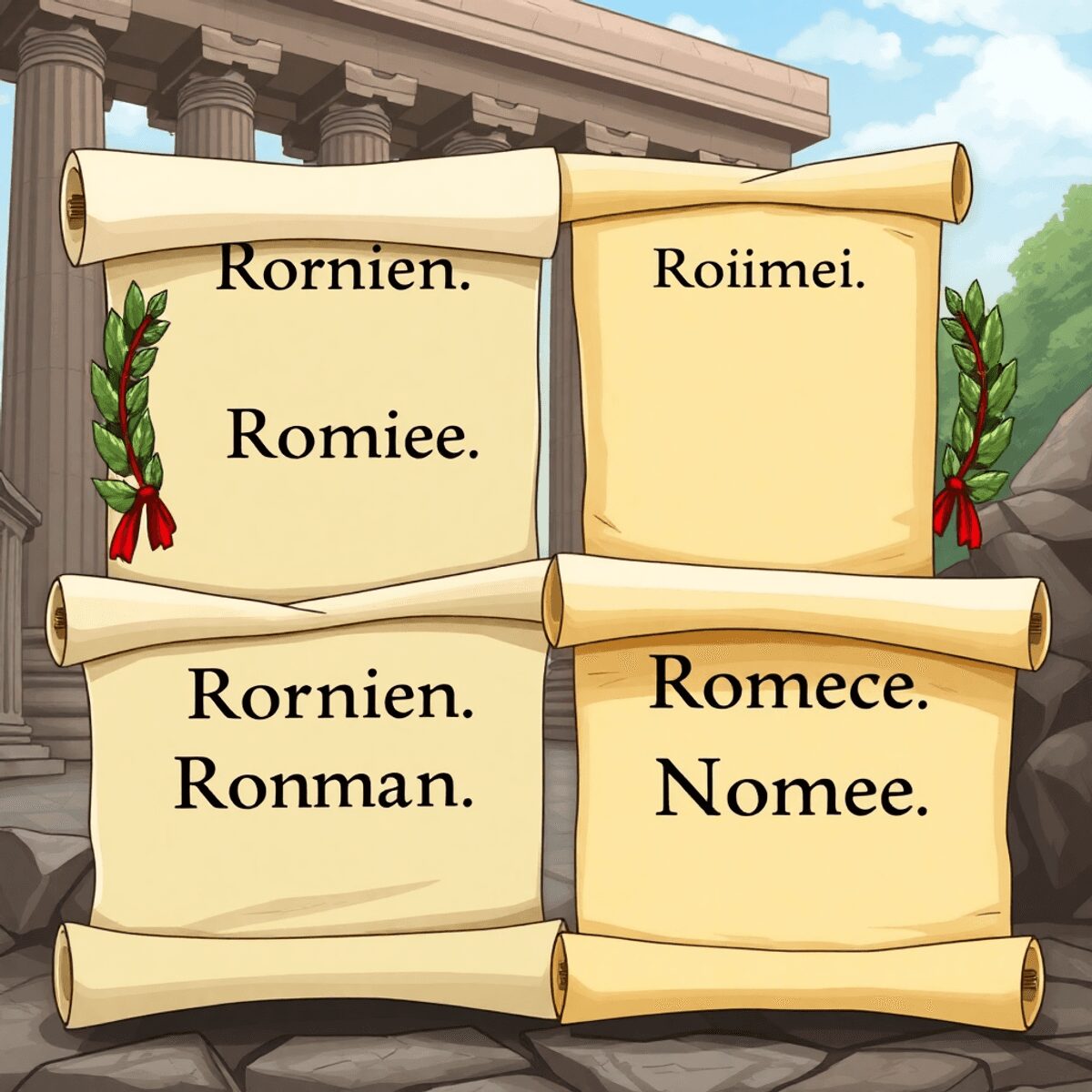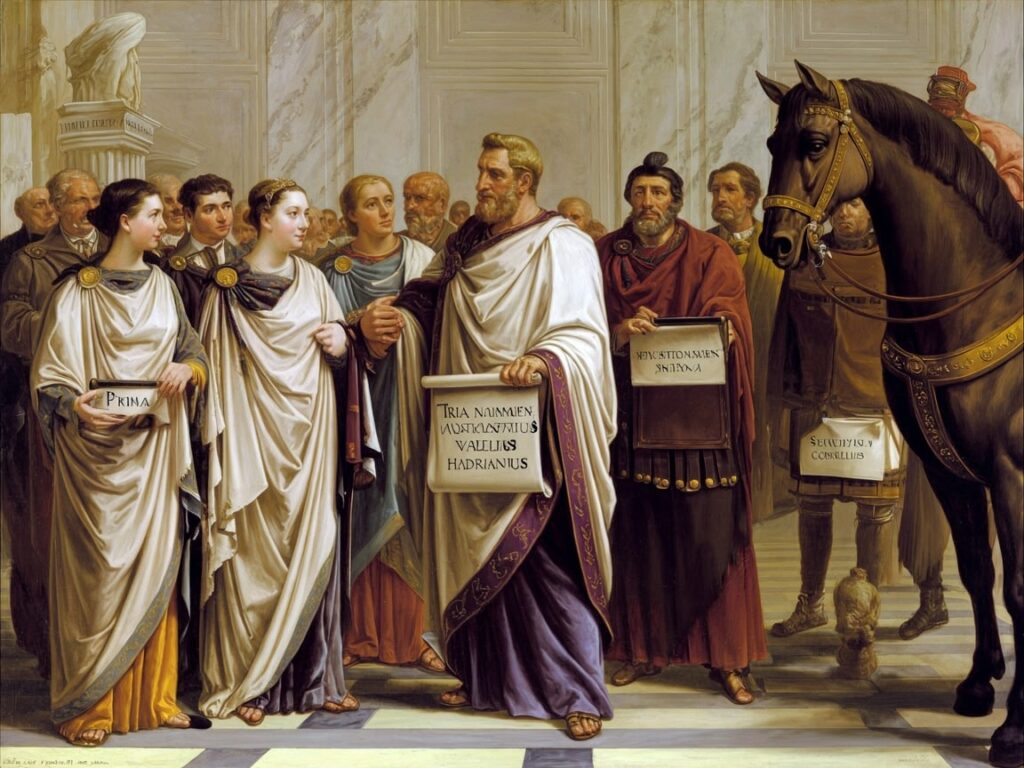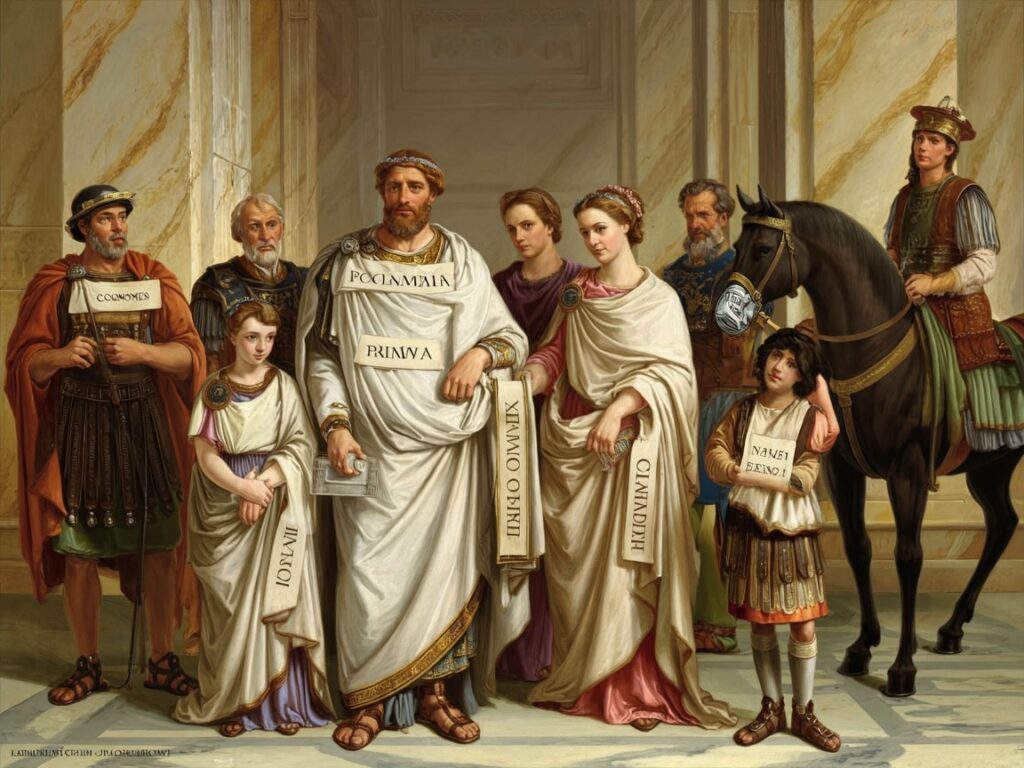Roman naming customs are a unique cultural practice that significantly shaped ancient Roman identity. The Roman naming system was more than just a way to identify people; it was a complex system that conveyed information about family background, social status, and political connections. Names had meanings that went beyond the individual—they defined social identity and indicated membership in Rome’s intricate society.
In this blog post, you will learn:
- The structure of the traditional Roman male name, known as the tria nomina
- How women’s names differed and what they reveal about gender roles in antiquity
- Ways naming conventions expressed social status and political power
- The evolution of these customs through changes in citizenship and empire
- The lasting legacy of Roman naming practices in modern European surnames
Understanding Roman naming customs provides valuable insights into how personal and social identities were formed in one of history’s most influential civilizations.
I’m sorry, but it seems that there is no text provided for me to improve. Could you please provide the text you’d like me to work on?

Naming Customs for Women in Ancient Rome
Roman women’s names followed a distinct pattern compared to their male counterparts, reflecting different social roles and conventions. Unlike the three-part tria nomina used by men, female naming conventions were simpler but carried significant meaning within Roman society.
Feminine Nomenclature: Women were primarily identified by the feminine form of their father’s nomen, the gens or clan name. For example, a daughter of the Claudius family would be called Claudia. This use of the feminine nomen emphasized family lineage over individuality.
Absence of Praenomina: Typically, Roman women did not have praenomina (personal given names) as men did. This omission highlights how personal identity for women was often tied more closely to family identity than personal distinction.
Differentiating Daughters Within a Family:
- When multiple daughters existed, Romans used descriptors such as Maior (the elder) and Minor (the younger) to distinguish between them.
- Sometimes numbers indicated birth order: Prima, Secunda, Tertia, etc.
- In some cases, additional cognomina or nicknames might be added to further identify individuals, especially among elite families.
This system underlines how Roman women’s names functioned less as individual labels and more as markers of their familial and social connections. The emphasis on the gens name reinforced both heritage and status in a patriarchal society that valued lineage and clan identity above personal names for females.

How Roman Names Reflect Social Identity
Roman names were more than just labels; they carried significant meaning about a person’s social standing and family background in ancient Rome. They were intricately connected with power dynamics and societal narratives, as explored in the book “Roman Naming Customs: How Identity Was Crafted in Antiquity”. Here’s how different parts of a Roman name conveyed information about one’s social identity:
The Three Parts of a Roman Name
- Praenomen: This was the personal name given to an individual. While it identified someone uniquely, it didn’t reveal much about their social rank.
- Nomen: This part of the name indicated which gens (clan) a person belonged to. It often conveyed information about their family’s reputation, history, and legal rights.
- Cognomen: The cognomen further specified an individual’s identity within their gens. It could refer to specific ancestors, physical characteristics, or accomplishments.
The Significance of Certain Names
Some nomina (plural of nomen) held considerable political significance. For instance, the name Julius immediately linked someone to the influential Julian clan known for Julius Caesar and his descendants. This connection brought instant recognition and implied potential political ties or ambitions.
Names as Symbols of Honor and Propaganda
Cognomina sometimes served as symbols of honor or political messaging. Names like Scipio or Africanus celebrated military victories and publicly reinforced the glory of their families. When such cognomina were adopted or added, it indicated alliances or prestigious adoptions, signaling changes in social status.
The Role of Names in Defining Social Roles
Names acted as shorthand for indicating a person’s role within Roman society. Different groups such as senators, equestrians, freedmen, and slaves were identified through specific naming practices:
- Senators typically had traditional Roman names without any additional titles or designations.
- Equestrians often included their father’s name as part of their own name to signify their status as members of the equestrian class.
- Freedmen usually took on the nomen (family name) of their former owner while incorporating their own personal name as a cognomen to mark both their new status and previous servitude.
- Slaves were identified solely by single names given to them by their owners without any indication of lineage or family connections.
For a deeper understanding into how these naming conventions worked and their implications on social identity in ancient Rome, consider exploring this comprehensive resource on Roman names.

Evolution and Decline of Roman Naming Practices
The decline of Roman names began notably after the Constitutio Antoniniana in AD 212, which granted Roman citizenship to most free inhabitants of the empire. This legal shift caused a dramatic increase in new citizens adopting Roman-style names. The praenomen, once a key personal identifier within limited usage, lost much of its distinctiveness due to this mass incorporation.
- Cognomina gained prominence, evolving from mere family branch nicknames into essential markers of identity. These names carried more weight as they differentiated individuals within the expanding citizenry.
- Multiple cognomina became common, reflecting achievements, social status, or adoption into prominent families.
The fall of Western imperial authority in the sixth century AD coincided with a reduction in naming complexity. Administrative structures that supported detailed record-keeping and legal identity weakened, which affected how people used and transmitted names.
- Post-imperial naming systems favored simpler forms.
- The elaborate tria nomina system gradually faded from widespread use.
- Regional variations emerged as local traditions reasserted themselves over the centralized Roman model.
This period marks a transition from the intricate Roman naming conventions to more straightforward personal names, laying groundwork for medieval European nomenclature. The rich cultural significance embedded in Roman names diminished but left lasting traces in later naming practices across Europe.

Legacy of Roman Naming Customs in Modern European Surnames
The origins of medieval European surnames show a clear connection to Roman naming customs, even though names became simpler after the fall of the empire. The complex tria nomina system gradually gave way to simpler naming practices as Europe entered the Middle Ages. Most people adopted a single given name, often followed by an additional descriptor that eventually evolved into hereditary surnames.
Key aspects inherited from Roman customs include:
- Use of family or clan indicators: Just as the Roman nomen identified a person’s gens, medieval surnames frequently reflected family lineage or clan association.
- Descriptive additions: Similar to the Roman cognomen, medieval surnames often originated from nicknames, places of origin, occupations, or personal traits.
- Patrilineal transmission: The passing down of family names mirrored the Roman emphasis on paternal lines in identity formation.
Despite moving away from the multiple-name format, many European cultures retained structural elements rooted in Roman tradition. For example, Italian and Spanish surnames sometimes preserve suffixes like -ius or evolve from Latin roots. In England and Germany, surnames reflect occupational or geographic origins but owe their organizational logic to earlier Roman influence.
Roman naming customs established foundational principles for identity tied to family and social status. This legacy shaped how medieval Europe constructed personal and social identities through names — an influence still visible in modern European surname systems. The historical significance of these naming conventions further underscores their profound impact on our understanding of identity and heritage.

Conclusion
Studying Roman naming customs reveals much about how identity was crafted in antiquity. Names functioned as more than labels; they encoded social rank, family ties, and political affiliations. Understanding this system offers insight into the complex social structures that shaped Roman life. The legacy of Roman names endures in modern European surnames, connecting us to a past where identity was deeply intertwined with heritage and status. Exploring these customs enriches your appreciation of ancient society and highlights the lasting impact of Rome’s cultural practices on naming traditions today.

FAQs (Frequently Asked Questions)
What was the traditional structure of Roman male names in ancient Rome?
Roman male names traditionally followed the tria nomina system, comprising three parts: the praenomen (personal name), nomen (clan or gens name), and cognomen (family branch nickname). This structure was distinctive in Roman culture and helped differentiate individuals within society.
How did Roman naming customs reflect social identity and status?
Roman names served as markers of social rank and family heritage. Certain nomina and cognomina indicated political connections and social standing, making naming conventions a key element in expressing one’s identity and position within ancient Roman society.
In what ways did naming customs differ for women in ancient Rome compared to men?
Unlike the male tria nomina system, Roman women typically used feminine forms of their father’s nomen as their primary identifier. To distinguish daughters within a family, terms like Maior (elder) and Minor (younger) were employed, reflecting different conventions in female naming practices.
How did Roman naming practices evolve after the fall of the Western Roman Empire?
Following widespread citizenship grants, the importance shifted from praenomina to cognomina. After the fall of Western imperial authority, the complexity of Roman naming declined, leading to simpler post-imperial naming systems that gradually moved away from traditional multi-part Roman names.
What is the legacy of Roman naming customs in modern European surnames?
Roman naming traditions influenced medieval European surnames by transitioning from multi-part names to simpler single-name systems. Despite the decline after the empire’s fall, these customs left an enduring impact on later European naming conventions still observable today.
Why is studying Roman naming customs important for understanding ancient social structures?
Analyzing Roman naming customs provides insights into how identity was crafted in antiquity, revealing connections between personal names, family heritage, social status, and political affiliations. This understanding helps decode ancient societal organization and cultural practices.

